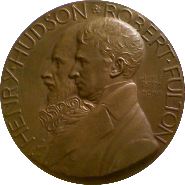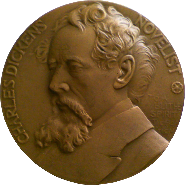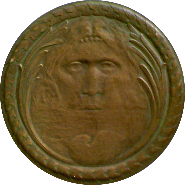Circle of Friends of the Medallion
The Circle of Friends of the Medallion (1908-1915) society was the first organized group that seriously attempted to promote interest in medallic art in the United States. Earlier attempts at popularizing medals, for example the short-lived, three-issue American Art Union (1847-1849), had failed and America just did not seem ready for a medallic society akin to the successful Art-Union of London.
The medal and coin collector Robert Hewitt, Jr. of New York had been following the European art medal societies with great interest. In 1908 he joined with veteran writer and arts organizer Charles de Kay to found a similar organization in the United States. They named their organization the Circle of Friends of the Medallion and planned to issue two medals per year on a subscription basis. One year later, in 1909, they were finally ready to launch with a charter membership group of 500 individuals.
The process by which sculptors and subjects were chosen was highly unbureaucratic. A committee of members, called the Art Committee, chose a subject and attempted to recruit a sculptor to render it. There were no competitions between proposals submitted by different sculptors. The sculptor was given great freedom. The only expectation was that he would do his best and that the medal bearing the sculptor's name would exemplify his particular style and strengths.
The finished medals were distributed in little brown books that included a few pages of background, explanations, or sculptor's remarks. De Kay was particularly emphatic about the merits of this distribution mechanism. In his experience, medal owners frequently had no display cabinets and were generally at a loss to recall where a medal was, if it was required.
The Circle chose the budding Medallic Art Company of New York to produce their medals. In 1909 it only existed as a division of Deitsch Brothers, a maker of leather handbags that were decorated with embossed ornaments so popular at the time. The brothers Henri and Felix Weil were the metal workers in this division and bought the company from Deitsch brothers in 1910 after the first two issues had been struck under the Medallic Art/Deitsch label. Unfortunately for the Weil brothers, the Circle of Friends contract was sold separately to Davison's of Philadelphia. Davison struck all issues from 3 to 11 before the Circle finally returned to Medallic Art Company for the last issue in 1915.
The Circle vanished rather abruptly and unexpectedly in 1915. They had plans for several more medals but nothing came of them. Circle members were left without the organizing core that had kept medals coming. This was to be the state of affairs for fifteen years until former Circle subscriber George Dupont Pratt co-founded the Society of Medalists in 1929.
Collecting Circle of Friends of the Medallion
For the collector, the Circle of Friends series is attractive for several reasons:
- The medals are highly appealing and very decorative. Many are represented in museum and college collections.
- The medals generally trade between $100 and $500. As there are only twelve of them, you can complete the series without beggaring yourself.
- There is a decent amount of trading at almost all times, so it won't take you forever to build or dispose of your collection by dealer or auction. With a little bit of luck, I have been able to almost complete the series in a year.
- The medals have held their value well over time.
- Once you have completed your basic collection, you can branch out into the variants. Some medals exhibit variations in patina and edge lettering, depending on where and when they were struck.
- There is an authoritative guide in the form of David Thomason Alexander's book that tells you all you want or need to know about the medals.
But most of all, the medals are really enjoyable and that's of course the only reason you should collect them. If you hold them for a long time, they probably won't be a bad investment either.
Next Steps
- Take a look at all the medals in the other tabs of this page. There are two tabs that lead to pictures: Medals and Variants. The Medals tab leads to a long list medal images, both obverse and reverse. The Variants tab leads to a grid of obverse medal images. You can configure the grid to ignore some variations while paying attention to others. For example, you can select that you don't care about differences in edge lettering but do care about differences in patina.
- Contact me if you are interested in buying or selling medals or want to help me improve the site. I am always interested in buying to complete or improve my own collection. Sometimes I have duplicates that I would be willing to sell. If you cannot or will not sell medals that I still need, at least share your high-quality pictures so I can complete the Variants display section. If I don't have a picture for a medal, I don't have the medal in my collection and I would be interested in buying it.
- Check out the links in the Resources tab.
- Support this site with a small donation if you appreciate it as a resource and want to help me with hosting and bandwidth costs.
The table below contains both the obverse and the reverse of the 12 Circle of Friends of the Medallion issues. Some of the issues exist in more than one variant. Click on the Variants tab for an obverse view of these variations. Clicking on the medals brings up more information as long as it is available.
Loading variants might take a little bit of time. Please wait...
Contact me if you have links that might merit inclusion on this page or if you want to be listed as an auctioneer or dealer.
Additional Information
Auctioneers
Books
Dealers


